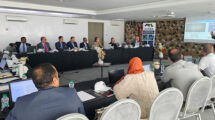Dorte Olesen is a mathematician with passions for advancing science and for empowering women – and the two have gone hand in hand through her career and her voluntary work for Zonta International, a global NGO working for equal rights and opportunities for women. She feels strongly about ensuring good education for girls all over the world and finds it crucial that girls are not scared away from entering studies in STEM.
In her professional life she has held top leadership positions at universities and been Director General of the Danish Agency for Information Technology for Education and Research from 1989-2011. She has also been very engaged in the European NREN community as president of TERENA from 2003-2009 and later Chair of the NRENPC and member of the Board of Directors of GÉANT. She is right now working at the Technical University of Denmark in the Department of Mathematics and Computer Science and is the President of the Danish Society for the Dissemination of Natural Science and an International Director at Zonta International.
Interview by: Silvia Fiore, GÉANT
Dorte, in 1988 you became the first Danish woman ever to be appointed as a full professor of mathematics and you also played a leading role in the development of Research and Education Networks in Denmark and more widely in Europe. What inspired you to give your contribution and make your own name in the internet world as a woman in STEM?
My interest in mathematics started at an early age, and for many years I found it really strange that when I visited some of my classmates at home, their parents asked funny questions like, “Isn’t mathematics difficult for a girl?”. At first, I was just surprised and said “no”, but eventually it dawned on me that I was given a signal that girls were not supposed to be as good at maths as boys, and in fact it was not very feminine to be good at maths.
However, at that point in time I became stubborn, since I was clearly better at maths than most of the boys, and so I ended up choosing the maths and physics specialisation in the last three years of high school, even though we were only a few girls doing that at the time, and it was clear that it did scare off some of the boys from asking me out to dance.
In high school I did really well in maths and physics and found the subjects very rewarding to work with, so I ended up studying maths and physics at university as well. The internet came a lot later, I only got involved in that because I was elected to leadership positions at university and at some point this led to my becoming the Director General of the Danish IT-centre for education and research, which at that time had just started focusing on High Performance Computing and High Speed Networking.
You acted as president of TERENA (2003-2009), were the head of the Danish NREN from 1989 – 2011, and also served on the Board of Directors of GÉANT during the merger of DANTE and TERENA (2014-2017). Can you share with us an achievement or a moment in your career that you hold dear to your heart and that symbolises your passion for advocating the use of the internet for research and education?
When Danish university professors in the early 1990s discovered the ease and speed with which they could collaborate with foreign colleagues over the internet, they came to us at UNI-C and asked if they could also get connectivity at home – they were used to working at home in the evening and now this new tool could help them there as well.
However, the Danish universities were not willing to pay for this, so we had to tell them that even though we could technically establish an at home internet service over their normal phone line, to a small personal computer, it would not be free of charge, in fact it would be rather expensive at that point in time. This was of course before there were private companies offering such a service to an ordinary PC user.
Still, so many wanted this service that we ventured to launch it – without subsidies from the universities or the government – but I knew that if we failed to get enough subscribers, we would have a financial loss and I could most probably wave goodbye to my job as Director General, so it was really a crucial moment. And we would not have dared do this if we had not also received permission to sell this service to a broader public. Well, the short version of the story is that it was a roaring success, and UNI-C thus became the first Internet Service provider to PC users in Denmark, and we managed to have this business for seven years before the ‘teleliberalisation’ came to Denmark and new Telcos moved in – they then all offered to buy our ISP business, and we ended up selling it to Tele2 which for 10 years ran it as a daughter company, UNI2.
In all your years of experience in the Community, what have you seen changing and improving in terms of greater female representation in the male-dominated STEM fields?
One of the important steps has been for many universities all over the world trying to actively encourage female applicants, both for the studies and the research positions in STEM. But it has been a very slow process, since many girls have already early in life accepted the myth that they were not really good at STEM subjects or have given in to the fact that their surroundings did not see them as feminine enough if they were interested in these subjects.
For quite some time now, universities in Denmark have been keen to encourage girls to study in the STEM field. Apart from general communication about this, there are “Girls in Science”, or “Girls in Information Technology” camps being arranged by several universities, where female high school students can come and spend a week, getting through a special programme. This is typically placed in a winter holiday week. Already many years ago, the physicists at the Niels Bohr Institute in Copenhagen started a “Women in Physics” campaign which has actually really encouraged quite a number of young women to study physics.
But these things take time, and if you want to enter a research career, there is a demand for spending a couple of years with a research group in another country – this can really be difficult for many young women since this is at a point in time when they would normally be starting a family, and having your husband move with you is still also more difficult than it is for most young men to have their wife go with them. If we want many young women to become researchers, we need a more flexible approach to the career paths than what we see today, at least here in Denmark.
On occasion of the Women’s History Month, we have gathered together outstanding female leaders in STEM and male advocates from the GÉANT community in a series of video episodes to celebrate what gender diversity in the workplace can achieve but also to reflect on what we can do better. A bold mission with a potential impact that goes into the wider community and that, we hope, can influence sustainable changes. Can you tell us in a nutshell why you think gender diversity matters and what we, as organisations that aim to inspire change, can do to really build gender diverse teams?
If all the researchers and leaders in STEM were male, you would statistically simply only have half the talent mass available. To rule women out of these areas is to deprive the areas of half the talents. That is obviously a really bad strategy from the point of view of these sciences, and of course it is also bad with barriers for the women who are keen to go into these fields. So, it is really a lose-lose situation if you do not encourage gender diversity.
There is no reason to think that women are less capable than men in these areas – but as illustrated by my own childhood stories, that was the “myth” that seemingly both men and women had accepted and were propagating for quite some time, and that of course has affected a lot of girls during their upbringing, so they have felt less secure about their own capabilities.
So, I think a basic step is to make it clear to everyone that being good at Science, Technology, Engineering and Maths has nothing to do with gender. This is not a simple process, since such myths have existed for a long time, and are being presented to girls at a very young age.
But a good place to start for the NRENs and GÉANT is to make the great role models that are already working in the community very visible – exactly like you are doing right now with the Women in STEM campaign – so keep looking for opportunities to put a focus on the existing role models.
Before we go, looking back at your younger self just starting a career in STEM, what would you say to her? Is it the same advice you would give to a woman in STEM today?
Actually, if I had known how many obstacles there would be in the early stages of my career – when the basic view in Denmark at the completely male dominated Maths Departments still was that as a married woman I did not really need a job, so I really ought not apply for a permanent position if there were male applicants who had a family to support – I think I might be advising my younger self to choose a different career path, most probably as a medical doctor, since that was also an occupation that I seriously considered.
Fortunately, this situation has changed completely – so today my advice is to push on and just smile if you happen to run into some old timers who still think that women are not as capable as men in the STEM subjects. They do exist, but fortunately they now seem to be a clear minority.
This article is featured on CONNECT39! Read or download the full magazine here







